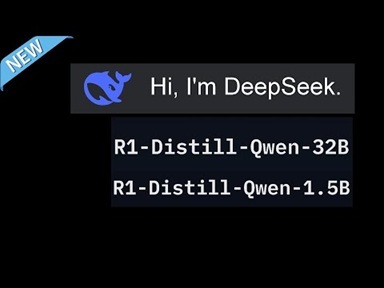
Introduction
This article explores recent advances in artificial intelligence language models, focusing on DeepSeek’s groundbreaking R1-Distill series launched in January 2025. We examine the sophisticated architecture behind DeepSeek’s reasoning models and their innovative fusion of powerful capabilities with efficient design. The article demonstrates how these models have been optimized into compact, open-source versions that maintain high performance while running locally, making advanced AI technology more accessible to developers and researchers—including practical implementation examples.
About DeepSeek R1-Distill-Qwen-32B Reasoning LM
DeepSeek R1-Distill-Qwen-32B is a powerful language model designed for advanced reasoning tasks. It’s part of the DeepSeek R1 family, known for its exceptional performance in areas like mathematics, coding, and complex reasoning challenges.
Key Features
- Distilled from a Large Model: This model is created through a process called “distillation.” Essentially, it learns to mimic the behavior of a much larger and more complex model (in this case, Qwen-32B). This allows it to achieve impressive reasoning capabilities while being more compact and efficient.
- Reasoning Focus: DeepSeek R1 models are specifically trained to excel at tasks that require logical thinking, problem-solving, and understanding intricate relationships between concepts.
- Open-Source Availability: The model and its associated tools are open-source, making it accessible to researchers and developers for further exploration and improvement.
How it Works
- Distillation Process: A large language model like Qwen-32B is used to generate a massive dataset of high-quality reasoning examples.
- Training: The DeepSeek R1-Distill-Qwen-32B model is then trained on this dataset, learning to replicate the reasoning patterns and problem-solving abilities of the larger model.
- Fine-tuning: The model can be further fine-tuned on specific datasets or tasks to enhance its performance in particular areas.
Applications
- Research: DeepSeek R1 models can be valuable tools for research in areas like natural language understanding, artificial intelligence, and cognitive science.
- Development: Developers can leverage these models to build innovative applications that require advanced reasoning capabilities, such as:
- AI assistants: Creating more intelligent and helpful virtual assistants.
- Educational tools: Developing personalized learning experiences that adapt to individual student needs.
- Scientific discovery: Assisting researchers in analyzing complex data and formulating hypotheses.
In essence, DeepSeek R1-Distill-Qwen-32B represents a significant step forward in the development of language models capable of sophisticated reasoning. Its open-source nature and impressive performance make it a valuable resource for the AI community.
Video about DeepSeek R1-Distill-Qwen-32B:
Technical Overview for the video about DeepSeek R1-Distill-Qwen-32B:
DeepSeek Version 3 Base Architecture
- Implements a mixture of experts system with 0.6 trillion total parameters
- 37 billion parameters are activated per token using an intelligent router
- Training involved 15 trillion diverse tokens
- Required approximately 3 million GPU hours for base model training
R1 Model Development Pipeline
- Cold Start Phase
- Initial fine-tuning of DeepSeek V3 base model
- Implemented readable pattern with summary tokens
- Focus on reasoning capabilities
- Training Refinement
- Retraction sampling implementation
- Supervised fine-tuning using 800,000 samples
- Integration of non-reasoning tasks (writing, role-playing, etc.)
Distilled Models Series
- Range of sizes: 1.5B, 7B, 14B, and 32B parameters
- Based on Qwen architecture
- Open-source under MIT license
- Available on Hugging Face platform
Performance Analysis
- DeepSeek R1-Distill-Qwen-32B shows competitive performance against:
- GPT-4 Omni
- Claude 3.5 Sonnet
- OpenAI’s O1 Mini
- Strong performance in mathematical tasks (93.9-94.5% accuracy)
- Notable performance gap in coding tasks between different model sizes
Implement DeepSeek R1-Distill-Qwen-32B locally with example:
1. Prerequisites
- Hardware: A powerful machine with a strong GPU (NVIDIA recommended) and ample RAM (at least 32GB) is ideal for running this model effectively.
- Software:
- Python: Install Python 3.7 or later.
- Hugging Face Transformers:
pip install transformers - CUDA Toolkit (if using GPU): Install the CUDA Toolkit corresponding to your NVIDIA GPU driver version.
- Torch:
pip install torch torchvision torchaudio --extra-index-url <https://download.pytorch.org/whl/cu118> (replacecu118with your CUDA version) - Hugging Face Hub CLI:
pip install huggingface_hub
2. Download the Model Weights
- Hugging Face Hub: The easiest way to download the model weights is through the Hugging Face Hub. You can choose from various quantization levels (Q2_K, Q3_K, Q4_K, etc.) depending on your hardware limitations and desired performance/accuracy trade-off.
Bash
huggingface-cli download bartowski/DeepSeek-R1-Distill-Qwen-32B-GGUF \
--include "DeepSeek-R1-Distill-Qwen-32B-Q4_K_M.gguf" \ # Example: DownloadQ4_K_M quantization
--local-dir ./
3. Load and Use the Model
Python:
from transformers import AutoModelForCausalLM, AutoTokenizer
model_name = “bartowski/DeepSeek-R1-Distill-Qwen-32B-GGUF”
tokenizer = AutoTokenizer.from_pretrained(model_name)
model = AutoModelForCausalLM.from_pretrained(model_name, torch_dtype=torch.float16)
#Generate text
prompt = “What is the capital of France?” input_ids = tokenizer(prompt, return_tensors=”pt”).input_ids
output = model.generate(input_ids)
generated_text = tokenizer.decode(output[0], skip_special_tokens=True) print(generated_text)
Explanation:
- Load Model and Tokenizer:
AutoTokenizerloads the tokenizer associated with the model.AutoModelForCausalLMloads the pre-trained model. - Prepare Input:
tokenizer(prompt, return_tensors="pt").input_idsconverts the input text into a sequence of integers (input_ids) that the model can understand. - Generate Text:
model.generate(input_ids)generates the text continuation based on the input prompt. - Decode Output:
tokenizer.decode(output[0], skip_special_tokens=True)converts the generated integer sequence back into human-readable text.
Example Usage:
- Reasoning:
“Solve the equation: 2x + 5 = 11”
“What is the square root of 144?”
“Write a Python function to find the factorial of a number.” - Coding:
“Generate a Python script to read a CSV file and plot a bar chart.”
“Translate the following Python code into JavaScript: …” - Creative Writing:
“Write a short story about a cat who goes on an adventure.”
“Compose a poem about the ocean.”
Important Notes:
- GPU Usage: If you have a GPU, ensure you have the necessary CUDA drivers and libraries installed.
- Quantization: Experiment with different quantization levels to find the best balance between performance and resource usage.
- Safety Guidelines: Be mindful of the potential biases and limitations of large language models. Use them responsibly and ethically.
This comprehensive guide should help you install and start using the DeepSeek R1-Distill-Qwen-32B model locally. Remember to refer to the official documentation and community resources for the latest information and advanced usage techniques.
Conclusion
The video highlights DeepSeek’s significant achievement in creating open-source models that compete with proprietary alternatives. The R1-Distill series represents a notable advancement in making powerful reasoning capabilities accessible through smaller, locally-runnable models.
Key Takeaways
- Open-source availability under MIT license
- Competitive performance with proprietary models
- Scalable options for different computational requirements
- Significant milestone in democratizing AI technology
- How to run locally



Very rapidly this website will be famous amid all blog viewers, due to it’s nice content
I’ve been browsing online more than three hours lately, but I never found any attention-grabbing article like yours.
It is pretty price enough for me. In my view, if all web owners and bloggers made excellent content material as you did, the net will probably be much more useful than ever
before.
Thanks for your personal marvelous posting! I seriously enjoyed reading it, you could be
a great author.I will be sure to bookmark your blog and definitely will come back in the future.
I want to encourage that you continue your great
writing, have a nice day!
Hey! I know this is somewhat off topic but I was wondering if you knew where
I could find a captcha plugin for my comment form? I’m using the same blog platform as yours and I’m having difficulty finding one?
Thanks a lot!
Hi, I had wrote a simple captcha plugin code for comment. Try it out and give comments. Thanks
Definitely believe that which you stated. Your favorite justification appeared to
be on the net the easiest thing to be aware of. I say to
you, I certainly get irked while people think about worries that they just
do not know about. You managed to hit the nail upon the top
as well as defined out the whole thing without having side-effects , people can take a signal.
Will probably be back to get more. Thanks